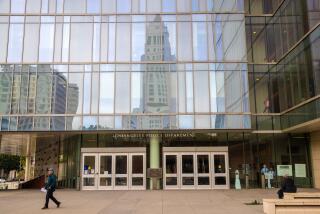When toxic masculinity wears a badge

- Share via
Book Review
The Highest Law in the Land: How the Unchecked Power of Sheriffs Threatens Democracy
By Jessica Pishko
Dutton: 480 pages, $32
If you buy books linked on our site, The Times may earn a commission from Bookshop.org, whose fees support independent bookstores.
Book Review
The Gangs of Zion: A Black Cop's Crusade in Mormon Country
By Ron Stallworth
Legacy: 288 pages, $30
If you buy books linked on our site, The Times may earn a commission from Bookshop.org, whose fees support independent bookstores.
A stock character in American crime stories is the maverick cop, the hero who bucks the system and bends the rules to bring in the bad guys. Intrinsic to the macho stereotype is that his (or, rarely, her) shield is backed up with physical violence, or that his ever-present gun is his ultimate claim to authority.
Two new books by Ron Stallworth and Jessica Pishko look at American law enforcement from different vantage points — both highlighting the perils when this fictional trope becomes reality.

Stallworth, the retired police detective and author of “Black Klansman,” takes readers on a ride-along as he chronicles his years with the Salt Lake Area Gang Project and its mission to break up gang activity among Mormon youth.

Pishko, an investigative journalist, makes readers witnesses to interviews with those who declare themselves “constitutional sheriffs.” They claim their legal authority rests in a certain reading of the Constitution, making them the arbiter of laws they administer — or don’t administer — in their jurisdictions.
As a lawyer herself, Pishko executes a feat of investigative reporting and astute legal analysis of how such sheriffs make their counties into fiefdoms.In the U.S., 3,000 sheriffs in 46 states are the primary law enforcement for 56 million Americans. Sheriffs make 20% of all arrests in the country and account for 30% of annual officer-involved killings. They are also overwhelmingly white and male: Black sheriffs constitute 4%; only 2% are women.
Race matters here. In the whitewashed histories of the American West, maverick sheriffs stood tall to protect white settlers — and in reality, they have been tools of white supremacists. Sheriffs sought and captured individuals who had escaped slavery; enforced Black Codes after Reconstruction; and aided the forced removal and killing of Native Americans on tribal lands. Today, sheriffs are the administrators of county jails, and as Pishko documents, they have control over many people targeted by racist law enforcement.
Jails are the site of gross violations of basic civil rights — detention without arraignment, warehousing of the mentally ill, the lack of segregation of violent criminals from those arrested for traffic violations — with horrific results. An arrest for shoplifting led to the death of the suspect in a Los Angeles County jail in 2022; in Fresno County in 2018, 11 prisoners died and 13 others required hospitalization after beatings.
Sheriffs have resisted efforts to reform county jails. As the sole administrators, sheriffs benefit directly from the daily payments they receive for each prisoner. Full jails mean maximum revenue.
If county voters continue to support them, there are few means by which to discipline sheriffs for corruption or for their failure to enforce laws with which they personally disagree. Many right-wing groups and white nationalists find sympathy and protection from sheriffs who hold similar beliefs. Pishko notes of the reliance on sheriffs for law enforcement: “We have no other mechanism in place to hold white supremacists accountable other than an institution that is, itself, a product of white supremacy.”
In sync with a growing fascist movement, constitutional sheriffs claim ultimate authority, even superseding federal law enforcement.
Pishko cites one example from Pinal County, Ariz., where Sheriff Mark Lamb declared as much at a rally. “We’re not politicians,” he said, even though he holds elected office and ran for Senate this year. “I’m your county sheriff. My job is to protect the people from bad guys and from government overreach.”
In a number of counties, constitutional sheriffs refused to enforce state or local mask mandates or regulations on firearms. They claim the right to check immigration status and have appointed themselves guardians of voting, citing the Big Lie and other conspiracy theories about “unfair” democratic elections.
The conservative Claremont Institute in California offers sheriff fellowships, at which sheriffs claiming extreme powers are provided with a legal framework and philosophical basis to legitimate themselves. Claremont’s radical promotion of its “nihilistic yearning to destroy modernity,” as Pishko puts it, has made it “an indispensable part of right-wing America’s evolution toward authoritarianism.”
Strict gender hierarchies, racial hierarchies and an aggressive heteronormativity that sees “deviance” everywhere informs constitutional sheriffs’ interactions with the public. They embody a toxic hypermasculinity that relies on violence, a willfully ignorant interpretation of the 2nd Amendment, and the rejection of traditional authorities such as scientists.
Violence and similar themes of hypermasculinity are explored in Stallworth’s fascinating account of his work when the Crips and the Bloods established strongholds in Salt Lake City. Teaching cops to profile kids not on the basis of race, but on the color symbols that marked them as gang members, he tried to divert the racial profiling that informs many cops’ interactions with Black and brown communities.
Stallworth writes that he also took gangster rap seriously as a source for understanding “an intellectual agitation to the body politic, especially the police establishment.” Many lyrics called out police brutality. Others, in his view, rejected prevailing culture’s “white societal emasculation” of Black men and instead “overemphasized their masculinity through the psychological subjugation of women.”
Stallworth’s own accounts of his policing are troubling too. In his telling, he takes the bait when provoked and lashes out, even escalating conflicts as when he challenges a gang member to a fight while his white armed partner stands by or when he responds to racial epithets from white supremacists with his own misogynist declarations of sexual domination of their mothers. In 2019, he shook hands with director Boots Riley, who had criticized a film based on Stallworth’s life, then incapacitated him while gripping a pressure point on Riley’s neck.
“The Gangs of Zion” alternates between well-researched, thoughtful analysis of gang culture and Stallworth’s walking of the thin blue line when he ignores suspects’ civil rights or asserts that rules made by those with no “street cop” experience do not apply to him.
Stallworth explicates the role white supremacy plays in bad cops’ policing of Black communities. Because his gang-related work was happening in Utah, the Mormon church looms large: Despite the arrest of white gang members with the Book of Mormon in their pockets, the church argues that only ethnic minorities are to blame for the area’s gang problem. Official church responses rely on the creation of their own facts to fit that narrative.
But Stallworth himself fails to question another troubling narrative: that individuals who deal drugs are “young punks” who need to be punished. He recognizes the racism that drove many to reject hip-hop; why doesn’t he discuss whether the “war on drugs” is also fueled by racism? It has served for decades as a pretext to target Black and brown people for mass incarceration.
Instead of wrestling with that reality, “The Gangs of Zion” embraces the idea of “good” cops enforcing the law with questionable methods. Stallworth is embodying that same reckless hypermasculinity seen in constitutional sheriffs profiled by Pishko; both cite troubling claims to justify using whatever means necessary to achieve their goals.
That’s where the key difference lies: While Stallworth was a police officer devoted to enforcing the law — however problematically — these sheriffs’ aim is lawless and a threat to society. They consider it their mission to defend white supremacy and a rising fascist movement.
Lorraine Berry is a writer and critic living in Oregon.
More to Read
A cure for the common opinion
Get thought-provoking perspectives with our weekly newsletter.
You may occasionally receive promotional content from the Los Angeles Times.










